- Author: Catherine Price
- Publisher: Ten Speed Press
- Rating: ⭐⭐⭐
- Link Amazon : Book Break up with your phone
- Pages: 192
- Time to Read: 7 Days
🚀 The Book in 3 Sentences
- The phone is a big opportunity, but a dangerous one as well
- It is important to be more mindful of your phone
- Implement digital detoxes in your daily life
🕵🏼Who Should Read It?
Almost 60% of people between 18-34 are addicted to their phones. There are endless studies that show the attention span of humans decreases. The average dopamine level that a person in this day and age experiences is astronomically high. This all means that this book could solve many problems for many people. What I have to say, though, is that if someone is already informed about the negative effects a phone can have, then the book can come off as somewhat repetitive. On the other hand, the 30-Day Challenge can also be undertaken by more experienced people.
☘️ How the Book Changed Me
The book improved my knowledge about the negative side effects of phones, but sadly, there were not a lot of new things contained in the book. That's why the book only gets 3 stars from me. I did not participate in the 30-Day Challenge of the book because I already do most of the actions. Probably the biggest impact the book had on me was raising my awareness about my phone.
✍️ My Top 3 Quotes
“The easiest way to break this habit is to make it harder to reach for your phone while you’re in bed.” Catherine Price
“Our Phones are designed to addict us.” Catherine Price
“social media represents the epitome of Trojan horse design.” Catherine Price.
📒 Summary + Notes
The book is structured into a theoretical and practical part. In the theoretical part, Catherine Price discusses why phones are so addictive and how they are designed to be addictive. She also explains how phones can change your brain. In the practical part of the book, Catherine Price presents a 30-Day Challenge that provides a step-by-step plan on how to break up with your phone.
The Wake-up
Phones are designed to addict us. Our phones have one of the biggest impacts on our brain chemistry. They are designed to provide us with rewards in various forms. As a result, our brain associates certain behaviours with rewards. The chemical released in this process is dopamine. Dopamine is the excitement hormone, and we greatly enjoy being excited. The problem is that any experience that triggers the release of dopamine is something we will want to experience again, which is how we become addicted to our phones.
Another reason why we are addicted to our phones is that they are equipped with subtle positive reinforcements. These reinforcements give us the feeling of control, and as we know, humans love to be in control.
The effects of our phones on our brains are widely known in science. One of those effects is the impact on our attention span. Studies have shown that the attention span of people between 18-34 is drastically shorter than the attention spans of older generations who have less contact with their phones. This is reflected in the movie industry, where movie scenes are now much shorter compared to older movies. There are significantly more cuts and images in modern movies, whereas scenes changed at a slower pace in older films. This effect has a significant impact on schools and the education system in general. Teaching materials need to be more interactive, playful, and interesting in order to engage students effectively.
Another effect of our phones is that due to the constant high level of dopamine we experience, we become desensitized to the dopamine released from smaller things like a beautiful tree or a hug from someone we like. As a result, we seek more time on our phones to achieve the same level of dopamine release.
Because of all these effects and the challenges associated with breaking up with our phones, specific tools can assist us in achieving that goal. Currently, I am working on a project that helps individuals maintain focus on important tasks. This is accomplished through a session blocking system, where users can specify the duration they want to concentrate, and the app locks their phone for that specified period. If you are interested and would like to learn more, please visit focuscoinapp.com and sign up for the newsletter to receive notifications about the app's launch.
The breakup
In this chapter of the book, Catherine Price provides the reader with a step-by-step plan on how to break up with their phones. This plan is outlined in a 30-Day Challenge, designed to gradually free oneself from excessive phone usage.
The 30-Day Challenge begins with small but impactful changes, such as disabling notifications, logging out of or deleting social media apps, and organizing distracting apps into a single folder. Additionally, changing the phone background to a text that serves as a reminder to stay aware is recommended.
As the 30-Day Challenge progresses, Catherine introduces more advanced techniques like the WWW (What for, Why, and When). Implementing and adhering to the WWW concept may not be easy, despite its simplicity. To practice the WWW, individuals are encouraged to ask themselves the following questions each time they feel the urge to reach for their phones:
What For? What are you picking up your phone to do? (For example, to check your email, browse Amazon, order dinner, kill time, and so on.)
Why Now? Why are you picking up your phone now instead of later? The reason might be practical (I want to take a photo), situational (I’m in the elevator), or emotional (I want a distraction).
What Else? What else could you do right now besides checking your phone?
If, after answering these questions, you still find it reasonable to pick up your phone, you are allowed to do so.
Furthermore, Catherine Price suggests an intriguing approach known as "detox days." This entails locking your phone away for an entire day. It can be a shared activity with your partner, friends, or even your entire family.
Now armed with these newly learned strategies, I hope you will be able to successfully break up with your phone. I look forward to seeing you in my next blog post.
With regards
Devin Hasler

